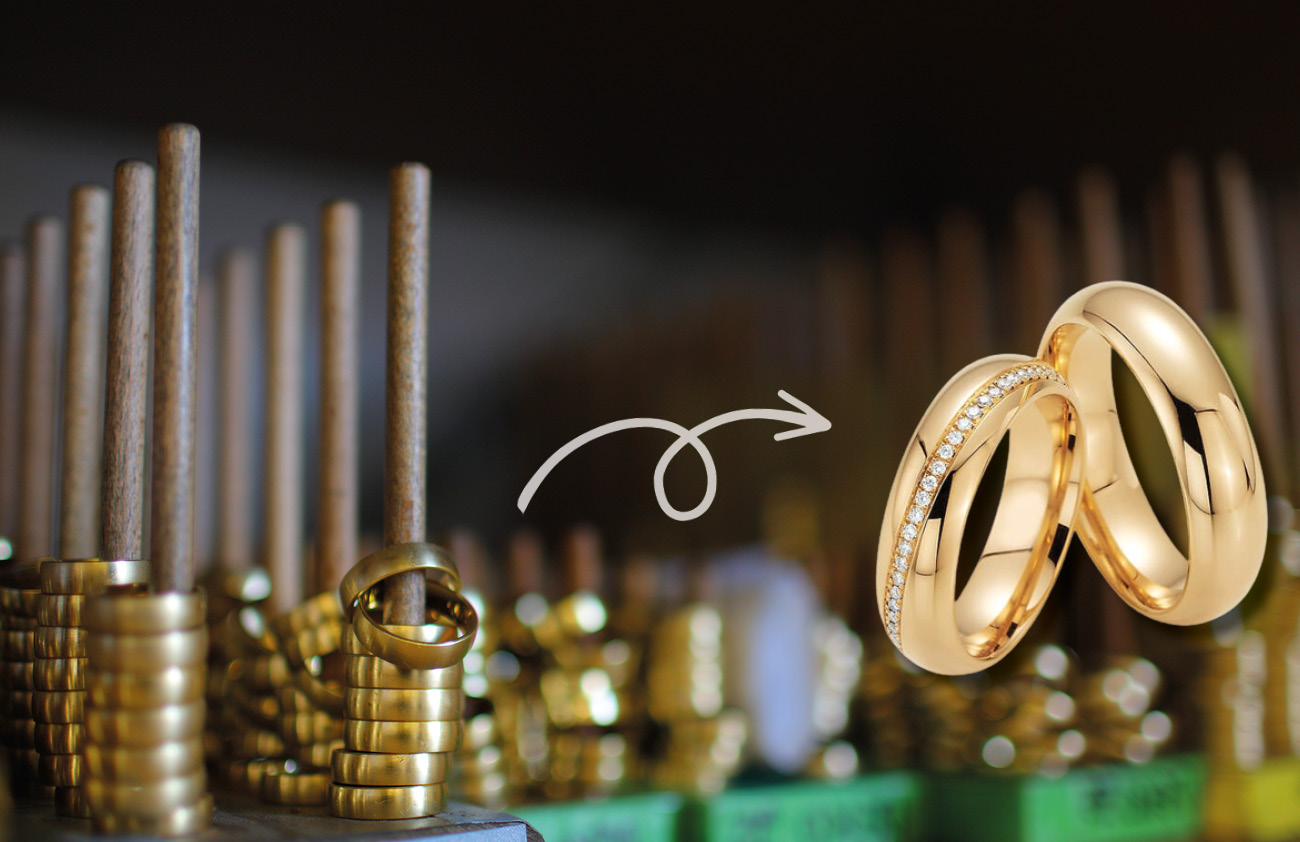Hardly any other piece of jewelry accompanies its wearer as constantly as wedding rings. From the moment the rings are presented at the wedding, they accompany couples throughout their lives as a couple.
Fischer Trauringe therefore not only attaches great importance to special design, but also places the highest demands on the quality of every wedding ring it produces - after all, the wonderful feeling of looking at your own wedding ring with pride and love should last a lifetime.
Below we take you step by step on the journey that your rings go through before they find their way to you. The Fischer company philosophy is lived out in each of these production steps: tradition meets innovation, modern machines complement the finest craftsmanship - and all this with the highest quality standards.
Edit blanks
Raw ring production
The first step in the manufacturing process is blank production. For this, the components for the different alloys are first mixed and then melted. The molten material is then poured strand by strand into round or rectangular profiles. The material is then rolled and punched out as blanks.
Cold forming rings
These blanks are then cold-formed. To do this, they are clamped between two guide rollers and the roller is guided onto the surface. Strong pressure is applied to expand the material further and further to achieve the desired ring size.
This process is one of the most important steps in wedding ring production in terms of surface quality and hardness.
You are currently viewing a placeholder content from YouTube. To access the actual content, click the button below. Please note that doing so will share data with third-party providers.
Turning
If you have already selected your desired rings with the Konfischerator you will certainly have noticed the variety of individual shapes and profiles. The ring is given these in the turning processing step.
The inner rounding of the rings - also known as crowning - is adapted to the shape and width of the model, which ensures maximum wearing comfort. The edges are smoothed and the final size of the ring is turned with the utmost precision using a CNC machine.
Lasering and milling
Many of Fischer 's wedding rings have unique patterns created by grooves or indentations, which are produced by laser cutting or milling on precision machines.
Here, the rings are also prepared for later setting by drilling and milling the stone positions of the diamonds.
Laser flora pattern
The models in the Flora collection are a special feature here. The characteristically detailed patterns of the highest quality are possible thanks to the high-quality laser technology used by Fischer .
The floral patterns, which are created as vector graphics, are adapted to the respective ring diameter and transferred to the laser machine. Depending on the alloy selected, laser parameters are entered to determine the depth of the engraving. Once started, the machine takes over the processing of the surface.
You are currently viewing a placeholder content from YouTube. To access the actual content, click the button below. Please note that doing so will share data with third-party providers.
Grasp
Setting diamonds is done entirely by hand and is therefore an elaborate craft. Like goldsmiths, the profession of setting is learned in a three-year apprenticeship. Fischer offers "rub-in", "channel" and "cut" settings.
Rub in
When rubbing, the diamond is integrated into the ring by lightly rubbing the surrounding precious metal over the stone.
Before the stone is placed, some preparatory work has to be done: First, the setting position is drilled slightly before the recess is widened until it is exactly the same size as the brilliant. Finally, the diamond is set and the actual setting begins. To do this, the surrounding precious metal is rubbed against the edge of the stone so that it lies lightly over its round edge.
You are currently viewing a placeholder content from YouTube. To access the actual content, click the button below. Please note that doing so will share data with third-party providers.
Blend
When setting cut stones - also known as pavé setting - notches are milled into a previously drilled hole. In order to fix the stones in place, small chips are set up with the help of a graver, which extend over the gemstone and hold it in place. These points are then shaped into a round shape using a so-called coring tool. This technique allows the diamonds to be set particularly close together so that entire ring surfaces can be covered with them.
As you can imagine, this process is quite time-consuming. It takes the setters at Fischer around 90 minutes to complete the ring you see at the beginning of the video. This loving craftsmanship is evident in every Fischer wedding ring and makes every pair of rings unique!
You are currently viewing a placeholder content from YouTube. To access the actual content, click the button below. Please note that doing so will share data with third-party providers.
Goldsmith and surface treatment
Another step where you can see how much manual work goes into each individual ring is the processing of the ring by a goldsmith. They carry out precision work on each ring, such as filing, soldering, laser cutting and diffusion welding.
Fischer offers you a wide range of different surfaces. These differ not only in their appearance, but also in their wearing properties. You can find an overview of all surfaces here .
Ice mat
The "ice matt" surface is particularly insensitive and resistant to signs of wear thanks to its strong structures. It is created by hand, in which the ring is polished all around in circular movements.
You are currently viewing a placeholder content from YouTube. To access the actual content, click the button below. Please note that doing so will share data with third-party providers.
Bark
The "bark" surface is given its individual character through coarse milling, which makes the ring robust against wear. After processing, as you can see in the video, the surface is sandblasted to give it its matt finish.
You are currently viewing a placeholder content from YouTube. To access the actual content, click the button below. Please note that doing so will share data with third-party providers.
Polished
The polished ring surface is an elegant classic for rings of all kinds.
Depending on the wedding ring model, very delicate areas are masked off where the surface should remain matt. In the video, you can see how the entire surface of a wedding ring is polished. The radiant finish makes the alloy of the ring stand out very clearly.
The ring is first polished on the inside with a small polishing brush, then on the outside and finally the finish is applied. This is done with so-called gauze bars and polishing buffs.
You are currently viewing a placeholder content from YouTube. To access the actual content, click the button below. Please note that doing so will share data with third-party providers.
Surface decorations
Mill handle
The fine decoration that you will find on many of the Fischer wedding rings is called a millgriff.
To create these, the ring is fixed on a collet and then rotated at a predefined speed. The mill handle tool is guided to the previously set position on the ring and transfers the pattern to the ring surface. The tool is only removed once all the small hemispheres have been formed. The result of this craftsmanship is a fine decoration that is not only visually impressive due to its light reflection, but can also be experienced to the touch.
You are currently viewing a placeholder content from YouTube. To access the actual content, click the button below. Please note that doing so will share data with third-party providers.
Engraving and hallmarking
The manufacturing process is completed by engraving the rings. You can choose whether you prefer a diamond or laser engraving. This allows you to personalize your rings with various symbols or (handwritten) text.
To guarantee the authenticity of the rings, the FS fisherman's mark is hallmarked.






